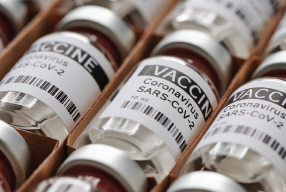
© M-Foto / shutterstock.com
NS: I volunteered at a mega-POD—a mega-point-of-dispensing site for vaccination administration. By definition, a mega-POD dispenses at least 1,000 vaccinations a day. I thought about going to the one at Six Flags Magic Mountain in Valencia, Calif., because it just sounded cool to go to an amusement park during such a dark time, but I’m actually happy that I went to California State University, Northridge (CSUN) instead. Like most mega-PODs, it was drive-through: People stay in their cars, the vaccinators come and administer the vaccine through an open window, and then the people drive to a waiting area where they stay for 15 minutes afterward (30 minutes if they have a history of allergic reactions or other specific concerns) to be monitored. Most of the people I saw stayed for 15 minutes.
Explore This Issue
April 2021ENTT: What was the physician volunteer role?
NS: At the CSUN site, nurses gave the vaccines and physicians were responsible for monitoring the patients. We were given an emergency toolbox, which contained a blood pressure cuff and a stethoscope, along with an EpiPen and an intramuscular Benadryl injection, and we literally just walked from car to car, checking on people, asking how they were feeling. At first the physicians sort of grumbled about that because it sounded less exciting and less important than actually giving the vaccines, but it’s really a critical part. There were some mild reactions that, as a physician, I needed to address. It was an important role, and it felt good to do it.
ENTT: What kinds of vaccine reactions did you handle?
NS: One person became very flushed—she had already left the mega-POD and had to drive right back in. Some people felt warm or a little nauseated or dehydrated, but I think this was probably secondary to having been in the car for a long time on a warm and maybe overwhelming day. Some said they were having trouble getting a deep breath, but they actually could breathe just fine. I think they were overwhelmed with emotion—I saw most of that in the last few hours of the day when the car line was slowing down.
ENTT: Is there anything about the people you saw that stands out in your mind?
NS: I remember one gentleman who was driving and had already gotten his immunization—I’d say he was in his mid to late 60s—and in the back seat was his father, who was well into his 90s. It was just lovely to see this family there, getting protected and staying safe. Overall, what struck me was that it was a fairly well-to-do socioeconomic group in general. It felt like a very singular demographic slice of Los Angeles County. It was a very clear message about the realities of vaccine access, at least in the early weeks of the vaccination roll-out. The people that I saw had access to computers, had been able to navigate the sites (which are very difficult), and had the transportation and time to get it done.